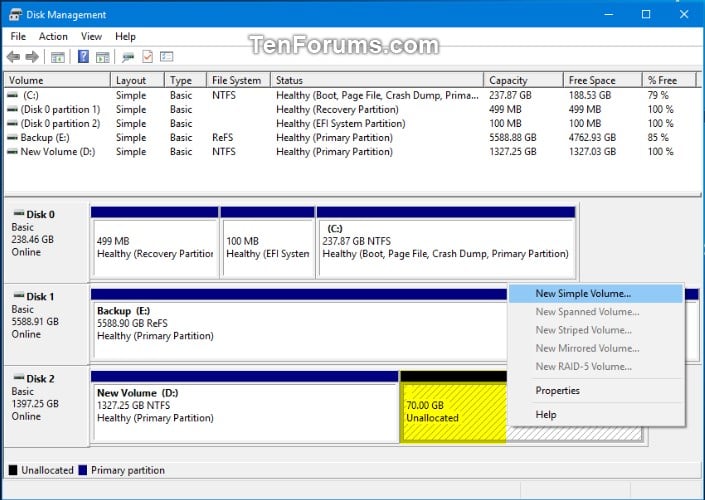
- #Windows volume manager how to#
- #Windows volume manager activation key#
- #Windows volume manager Patch#
- #Windows volume manager upgrade#
- #Windows volume manager software#
To control players, just use the mouse buttons on the taskbar: play/pause with the middle button (usually the wheel) switch to the next/previous tracks with right and left mouse buttons rotate the wheel to increase/decrease the volume. If you have music playing and want to watch a video, just start the video and Chameleon Volume will stop the music for you. It's like having your very own intuitive DJ at home!Ĭhameleon Volume synchronizes the work between media players and Skype and also controls the volume.
#Windows volume manager software#
This is now possible with advanced software Chameleon Volume that acts to pause your music and resume playback after the call is over.


#Windows volume manager how to#
Learn about Volume Activation and how to activate systems by using KMS and/or MAK.Imagine if your music were to magically stop when receiving an incoming Skype call instead of scrambling round to find and stop the player yourself. VLKs can be used only with Volume Licensing products they cannot be used with retail software or software that is preinstalled on a new computer (original equipment manufacturer, or OEM, products). Volume License Keys (VLK), including MAK and KMS, are issued to you under a specific license agreement and enable your organization to use the software that you have licensed. Therefore, Windows Server 2008 is not covered as a platform as an Office 2010 KMS host. Microsoft makes every effort to cover all of its previous platforms for compatibility however, new technologies may make it necessary to decide which previous versions will continue to be supported. If your organization has fewer than 50 PCs, the best option is to use Multiple Activation Keys (MAK) with Volume Activation Management Tool (VAMT). Run a Windows Server 2003 virtual machine on the Windows Server 2008 machine. Run the KMS host on a Windows 7 volume edition machine.
#Windows volume manager upgrade#
Upgrade the KMS host machine to Windows Server 2008 R2.ĭowngrade the machine to Windows Server 2003. If you are using Windows Server 2008 as a KMS host, here are your alternatives:
#Windows volume manager Patch#
(A Windows Server 2008 R2 KMS key is required.)Ī patch is not available to allow activation of Office 2010 clients. Windows Server 2008 is not supported as a KMS host to activate Windows 7 and Office 2010.Ī patch is available to allow activation of Windows 7 client machines. If you plan to deploy Windows 7 and/or Office 2010 by using Key Management Service (KMS) as the activation method, please note: The Office 2013 KMS host is supported on Windows Server 2008 R2, Windows 7 VL edition, Windows 8.1 VL edition, Windows Server 2012 R2, and Windows Server 2012 R2 for Embedded Systems. The KMS and MAK activation processes for Office 2013 are basically the same as they were for Office 2010, except that the Office 2013 KMS host is not supported on Windows Server 2003. Most likely, Office 2013 will use the same method. To help determine which activation method to use for Windows, see the Windows Volume Activation Planning Guide.

If you are planning a Windows deployment of Windows 7, Windows Server 2008 R2, Windows 8.1, Windows Server 2012 R2, or Windows Server 2012 R2 for Embedded Systems, you probably have the same considerations for Windows as for Office 2013.

For more information, see Active Directory-Based Activation Overview. There is a third model for completing volume activation called Active Directory-Based activation. The type of key entered in the product determines the activation method. Customers can use either or both activation methods in their environment. MAK activates systems on a one-time basis, using Microsoft's hosted activation services. KMS allows organizations to activate systems within their own network.
#Windows volume manager activation key#
Volume Activation provides two different models for completing volume activations: Key Management Service (KMS) and Multiple Activation Key (MAK). Volume Activation applies to systems that are covered under a Volume Licensing program and is used strictly as a tool for activation it is in no way tied to license invoicing or billing. It enables Volume Licensing customers to automate the activation process in a way that is transparent to end users. Volume Activation is a product activation technology used to activate Windows Vista, Windows Server 2008, Windows Server 2008 R2, Windows 7, Office 2010, Windows 8.1, Windows Server 2012 R2, Windows Server 2012 R2 for Embedded Systems, and Office 2013.


 0 kommentar(er)
0 kommentar(er)
